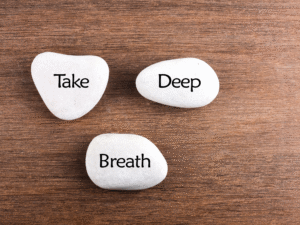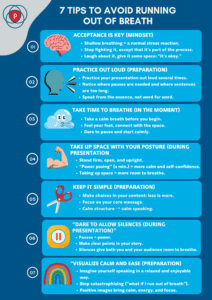3 TIPS TO AVOID RUNNING OUT OF BREATH DURING A PRESENTATION
I remember it well. During the first few years of my work as a consultant, I often found myself running out of breath while presenting. I felt embarrassed and ashamed. After such a presentation — where my breath once again failed me — I’d feel a brief sense of relief that it was finally over.
However, that relief quickly disappeared as soon as the next presentation appeared on the horizon. It was as if all the gears in my brain started spinning at full speed again, filled with “what if it happens again?” thoughts — and all the unpleasant emotions that come with them. I felt stressed, discouraged, and anxious.
These days, it rarely happens anymore.
And although this can be a tough nut to crack (in my case, the shallow breathing lasted about a year and a half), there are plenty of practical tips that can help — so that over time, this issue plays a smaller and smaller role for you too.
Below are the first 3 of 7 tips that made all the difference for me and for my students:
1) Accept That It Can Happen — And That’s OK. MINDSET
What I unconsciously did — by constantly thinking “what if it happens again?” — was actually increasing the chance that it would. Over time, I realized this more and more clearly.
When you keep focusing on what you don’t want to happen, you’re actually rolling out the red carpet for it!
How so?
When I finally accepted that “running out of breath” was simply part of the deal, something remarkable happened. It had happened so many times that I eventually just accepted it — and suddenly, it stopped happening!
Once I stopped obsessing over preventing it — pouring fuel on the fire, so to speak — the problem quietly disappeared like a thief in the night. I’ve seen the same thing happen with many of my students.
In short: Are you afraid it might happen again? So what? One person runs out of breath, another starts talking too fast, another fidgets with their hands. It’s universal. We all react in our own way when we find something nerve-wracking.
Try to look at it with a little more flexibility — maybe even some humour. Give it some air. Is it really such a big deal? Look at me — I survived a year and a half of shallow breathing and now I teach Presentation Skills workshops!
Running out of breath? It’s OK.
2) Practice Out Loud in Advance — PREPARATION
By practicing your presentation out loud several times beforehand, you’re already creating a path in your brain — what I like to call an elephant trail. This connects you to your story and gives you a solid foundation, making you less vulnerable to shallow breathing.
Here’s why:
a) You’ll notice where your story needs natural pauses — the “crossroads” on your elephant trail.
b) You’ll hear when your sentences are too long (often written-style sentences) that make you more likely to lose your breath — so you can shorten or adjust them.
c) You’ll realize when you’re trying to cram too much information into too little time — another major trigger for shallow breathing.
By going through this “out-loud” practice, you’ll naturally develop a feel — that Fingerspitzengefühl — for pacing and for where pauses are needed in your story.
Just as importantly, you’ll slowly start to dare to actually take those pauses. And that will help enormously with your breathing.
Note: this isn’t about memorizing every word. It’s about seeing a slide or a note and being able to tell the essence in your own words. That letting go is exactly what gives you more breath. It should be a loose elephant trail, not a rigid one.
3) Before You Start Presenting, Create Space and Calm Through Breathing — IN THE MOMENT
Speakers who take a moment to breathe and feel their feet on the ground before they start speaking begin their presentation with much more calm and focus.
Besides coming across as confident to the audience, it also gives you a solid, grounded start.
Why?
Because a good start is half the work. You begin from a place of calm, from a low and stable energy — rather than the rushed, high-breath energy that leads to problems.
That shallow breathing often comes from not taking a proper breath and starting to talk too quickly, without a stable foundation. Taking the time to breathe before you begin sounds simple, but it’s trickier than you might think.
Why? Because when we stand in front of an audience and see all those eyes on us, our instinct is to start talking immediately — to avoid the silence. And that’s the core of the problem. We’re terrified of pauses or of what people might think. So we rush through, without pause or calm.
How to turn this around? Practice it:
a) Take time for one good, grounding breath before you begin.
b) When transitioning between sections of your presentation, take a deliberate pause.
c) Consciously end sentences and key statements with a real full stop. Give your audience time to process what you’ve said — so they can actually have an opinion about it!
The more you practice this, the easier it becomes.
And it starts with you — daring to take that space, that calm, even when it feels nerve-wracking.
In the free download poster down below, you can find the extra 4 tips.
For now, you can start with:
- Accept — it’s OK.
- Practice out loud and create a loose elephant trail.
- Take your time — breathe and begin.
Good luck!
Warm regards,
Mabel
You can download the free 7 tips checklist poster as an pdf here.
FREE CHECKLIST



